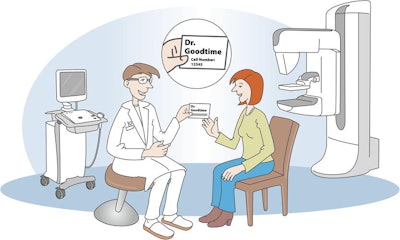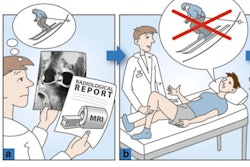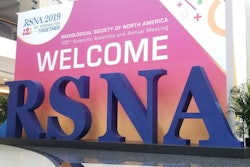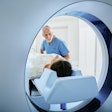
The simple act of radiologists giving patients their business card goes a long way toward helping patients remember the radiologist's name after an examination and enhancing the patient-doctor relationship, according to Swiss-Austrian research.
The findings of a study published online on 13 February in Cancer Imaging show that it's not necessarily complicated for radiologists to improve their interactions with patients, noted the team led by Dr. Andreas Gutzeit, a consultant breast radiologist at Hirslanden Klinik St. Anna in Lucerne, Switzerland.
 Dr. Andreas Gutzeit.
Dr. Andreas Gutzeit."Patients who are often stressed when undergoing exams have trouble remembering radiologists' names -- a business card could be an important tool in improving the professionalism of the service and patients' sense of well-being," he told AuntMinnieEurope.com.
"The whole issue is about the relationship that the radiologist offers to patients," he said. "If we want to show ourselves as relevant against artificial intelligence, we have to be reachable and responsive as human beings. If patients can't remember our name, that's not achievable."
Research has shown that more than 75% of patients don't understand the role of the radiologist, and up to 90% of radiologists do not directly engage with patients before or after an imaging exam, the researchers noted. In light of this, efforts have increased to shift radiologists from "behind-the-scenes" experts to patient-oriented specialists, and a good place to start is ensuring that patients can connect with their radiologists to better support a discussion of imaging results.
"We have noticed that despite our endeavors to discuss imaging results with our patients, a large number of them did not remember the radiologist's name and had no idea how to reach the radiologist if they had further questions later on," Gutzeit and colleagues wrote.
Study logistics
The study took place between February and July 2019 at breast imaging centers at Salzburg University Hospital and Hirslanden Klinik St Anna. It included 141 patients older than 18 years who underwent a routine imaging examination using mammography and ultrasound, for which the findings were categorized as BI-RADS 1 or 2. Two radiologists with nine and 19 years of experience, respectively, conducted the exams.
The patients who fit the BI-RADS criteria on immediate interpretation of the mammogram were streamed into group 1 or group 2. After completing the mammogram, the radiologist performed breast ultrasound and the results were discussed with patients.
At the beginning of the ultrasound exam, for group 1 (71 patients), the radiologist greeted the patient with the following: "Good morning, my name is Dr. Meissnitzer (MM)/Gutzeit (AG). I am your radiologist. Your mammography results are unremarkable. No suspicious abnormalities were detected. With your consent, I would like to perform ultrasound as well."
At the end of the consultation, the radiologist said goodbye to the patient as follows: "The ultrasound and mammography results were unremarkable. Do you have any further questions?" Following any discussion, the radiologist said, "I would also like to give you my business card; and you are welcome to contact me if you have any further questions. Goodbye!"
 Following the mammography and ultrasound examinations, patients were given the radiologist's business card (group 1). Image courtesy of Dr. Andreas Gutzeit.
Following the mammography and ultrasound examinations, patients were given the radiologist's business card (group 1). Image courtesy of Dr. Andreas Gutzeit.For group 2 (70 patients), the greeting and invitation to ask questions were identical, but no business card was given.
The ultrasound examinations and the discussion of the findings lasted 7.5 minutes, on average. The duration of discussion did not differ between groups 1 and 2.
Patients were then called one to seven days after the imaging examinations and asked eight questions by two trained patient interviewers from the hospitals' quality management staff. The telephone interviews were conducted an average of two days after the examination and lasted an average of 3.6 minutes.
Striking results
The researchers found that patients in group 1 could remember the name of the radiologist in 85% of cases. The patients in group 2, in contrast, could only remember the name in 7% of cases (p < 0.001).
Startlingly, 90% of the patients in group 1 believed it was very important that they were able to contact the radiologist at a later time, whereas only 76% of the patients in group 2 felt that this was very important (p < 0.025). A total of 87% of the patients in group 1 indicated they would contact the radiologist if they had any questions, whereas 73% of the patients in group 2 would have liked to be able to contact the radiologist but were unable to do so because they could not remember the doctor's name (p < 0.001).
The researchers found no difference between the groups with regards to the perceived competence of the radiologist (p = 0.166). There also was no difference as to whether the patient was likely to recommend the radiology department. All patients in both groups indicated they would recommend the radiology department to others; however, most patients in both groups didn't care where their gynecologist sent them. In both groups, almost all patients indicated how important it was to be able talk to the radiologist: 95.8% in group 1 and 94.2% in group 2 indicated that the final discussion with the radiologist was very important (p = 0.668).
The authors underlined that they did not seek to investigate how many patients called the radiologist after receiving a business card, but they confirmed that not a single patient in group 1 actually wrote to or emailed the radiologist.
Gutzeit and colleagues noted that the act of giving the patients a business card significantly increased their recall of the radiologist's name and could be an important factor in improving the relationship between patients and radiologists. Patients' desire to be able to contact the radiologist when questions arise also needs to be regarded as an important aspect of care, they added.
Radiologists need to demonstrate the importance of their service -- especially as artificial intelligence continues to change the field, according to the authors.
"If we assume that machines will soon be better than radiologists, there is only one route left to us: We should not behave like machines, but become empathic doctors who are responsible to our patients' needs before, during, and after their examinations -- something which patients would highly value," they concluded.



















